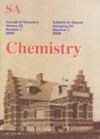Africa-UK Partnership for the Computer-aided Development of Sustainable Catalysts
IF 1
4区 化学
Q4 CHEMISTRY, MULTIDISCIPLINARY
South African Journal of Chemistry-Suid-Afrikaanse Tydskrif Vir Chemie
Pub Date : 2021-01-01
DOI:10.17159/0379-4350/2021/v74a1
引用次数: 0
Abstract
Collaboration is the cornerstone of modern science, driving the development of new knowledge, concepts, methodologies, and thought processes. The complementary expertise existing in South Africa, Ghana, Botswana, Namibia, and the United Kingdom has allowed the advancement in the field of sustainable catalysis showcased in the thematic issue of the South African Journal of Chemistry, to which this foreword is an introduction. Historically, the design, testing and characterization of the catalyst structure and analysis of reactants, intermediates, and products, has been at the centre of catalysis science. However, the advent of computer modelling has underpinned the predictive simulation of the geometries and properties of catalysts and their interaction with reactants, intermediates, and products. The inspection and assessment of simulated catalytic pathways and the effect of a range of environmental conditions have become an almost routine task in modern catalysis research, thereby supporting and complementing experiments. The modelling of various reaction mechanisms and the calculation of their kinetic and thermodynamic energy profiles has led to a new and realistic description of catalytic processes. The rapid progress of the computer-aided development of sustainable catalysts has been facilitated by innovative and accurate theoretical concepts and their implementation into a variety of software codes. The application of these computational tools to simulate complex systems and realistic problems have been driven by constantly expanding computational capacity. Most of the papers in this theme issue have used the South Africa National Centre for High Performance Computing (CHPC), the Cardiff University HPC systems, the pan-Wales network of computer clusters HPC Wales or its successor Supercomputing Wales (SCW), hosted by Cardiff University. The articles in this theme issue exemplify many of the major challenges in the contemporary computer-aided development of catalysts and materials for sustainable energy. The topical simulation of the lithium intercalation voltage in spinel-structured materials is explored in the paper by Malatji et al.1 In contrast, key issues in the development of computational models to describe cobalt and its oxide phases are addressed in the article of Cadi-Essadek et al.2 The paper of Phaahla et al.3 examines the phase transition in titanium nanoclusters using dynamic simulation methods, and the challenges in extrapolating binding energies to alkaline earth metal oxides are investigated by Escher et al.4 In the contribution of Botchwaya et al.,5 density functional theory calculations are used to model the surface and catalytic properties of zeolites. On the other hand, Meerholz et al.6 deployed atomistic simulations based on interatomic potentials to provide new insight into the thermodynamics and structure of the atomic distribution in metal alloy surfaces. Nyeptesi et al.7 have exploited in situ monitoring techniques to study the carbonate-catalyzed transesterification of sunflower oil for biodiesel production, whereas the hydrogenation of sorbic acid using Pdand Ni-based complexes as catalysts is illustrated in the work of Olaoyea et al.8 Finally, the article of Ungerer et al.9 demonstrates the key importance of the competitive adsorption of water and sulfur oxide on platinum surfaces, while Peck et al.10 examined the significance of the adsorption of hydrogen and oxygen on the surfaces of transition metals with varying magnetic ordering. The science reported in this volume celebrates the success of two collaborative research consortia between scientists in the UK and several African countries. Both the Newton PhD exchange programme ‘Computational Catalysis: a sustainable UK-South Africa partnership in high performance computing’, funded jointly by the SA National Research Foundation and the UK Economic and Social Research Council (ESRC: grant number ES/N013867/1), and the ‘New materials for a sustainable energy future’ programme, funded by the UK Department for International Development (DFID) under the Royal Society Africa Capacity Building Initiative, have enabled the collaborative work presented in this special issue. One of the highlights of these international research programmes was the conference attended by the combined consortia on the Potchefstroom Campus of North-West University in April 2019, where the researchers had the opportunity to present the work published here and discuss future collaborations. Finally, we are grateful to the South African Journal of Chemistry for their support of this theme issue. We hope that it illustrates the range and impact of the Africa-UK partnership for the computer-aided development of sustainable catalysts.非洲-英国计算机辅助可持续催化剂开发伙伴关系
协作是现代科学的基石,推动着新知识、新概念、新方法和新思维过程的发展。南非、加纳、博茨瓦纳、纳米比亚和联合王国现有的互补性专门知识使可持续催化领域的进展得以在《南非化学杂志》的专题问题中得到展示,本前言是对该杂志的介绍。历史上,催化剂结构的设计、测试和表征以及对反应物、中间体和产物的分析一直是催化科学的中心。然而,计算机建模的出现为催化剂的几何形状和性质及其与反应物、中间体和产物的相互作用的预测模拟提供了基础。在现代催化研究中,对模拟的催化途径和一系列环境条件的影响进行检查和评估几乎已经成为一项常规任务,从而支持和补充实验。各种反应机理的建模和它们的动力学和热力学能量分布的计算导致了催化过程的一个新的和现实的描述。创新和准确的理论概念及其在各种软件代码中的实现促进了可持续催化剂的计算机辅助开发的快速进展。不断扩大的计算能力推动了这些计算工具在模拟复杂系统和现实问题方面的应用。本主题的大多数论文都使用了南非国家高性能计算中心(CHPC),卡迪夫大学HPC系统,泛威尔士计算机集群HPC威尔士网络或其继任者超级计算威尔士(SCW),由卡迪夫大学托管。本主题刊中的文章举例说明了当代计算机辅助开发可持续能源催化剂和材料的许多主要挑战。Malatji等人在论文中探讨了尖晶石结构材料中锂嵌入电压的主题模拟1相反,Cadi-Essadek等人的文章解决了描述钴及其氧化物相的计算模型发展中的关键问题2 Phaahla等人的论文3使用动态模拟方法研究了钛纳米簇中的相变。Escher等人研究了推断碱土金属氧化物结合能的挑战。在Botchwaya等人的贡献中,5使用密度泛函理论计算来模拟沸石的表面和催化性质。另一方面,Meerholz等人6利用基于原子间势的原子模拟,为金属合金表面原子分布的热力学和结构提供了新的见解。Nyeptesi等人7利用原位监测技术研究了用于生产生物柴油的碳酸盐催化的葵花籽油酯交换反应,而Olaoyea等人的工作说明了使用钯和镍基配合物作为催化剂的山梨酸加氢8。最后,Ungerer等人的文章9证明了水和硫氧化物在铂表面的竞争性吸附的关键重要性。而Peck等人研究了氢和氧在不同磁有序过渡金属表面吸附的意义。在本卷中报道的科学庆祝英国和几个非洲国家的科学家之间的两个合作研究联盟的成功。牛顿博士交流项目“计算催化:英国和南非在高性能计算领域的可持续合作伙伴关系”,由南非国家研究基金会和英国经济和社会研究委员会(ESRC)联合资助;资助号ES/N013867/1),以及由英国国际发展部(DFID)在皇家学会非洲能力建设倡议下资助的“可持续能源未来的新材料”项目,使本期特刊中介绍的合作工作成为可能。这些国际研究项目的亮点之一是联合财团于2019年4月在西北大学Potchefstroom校区参加的会议,研究人员有机会展示在这里发表的工作并讨论未来的合作。最后,我们感谢《南非化学杂志》对本期主题杂志的支持。我们希望它能说明非洲-英国在计算机辅助开发可持续催化剂方面的伙伴关系的范围和影响。
本文章由计算机程序翻译,如有差异,请以英文原文为准。
求助全文
约1分钟内获得全文
求助全文
来源期刊
CiteScore
3.10
自引率
0.00%
发文量
6
审稿时长
>12 weeks
期刊介绍:
Original work in all branches of chemistry is published in the South African Journal of Chemistry. Contributions in English may take the form of papers, short communications, or critical reviews.

 求助内容:
求助内容: 应助结果提醒方式:
应助结果提醒方式:


